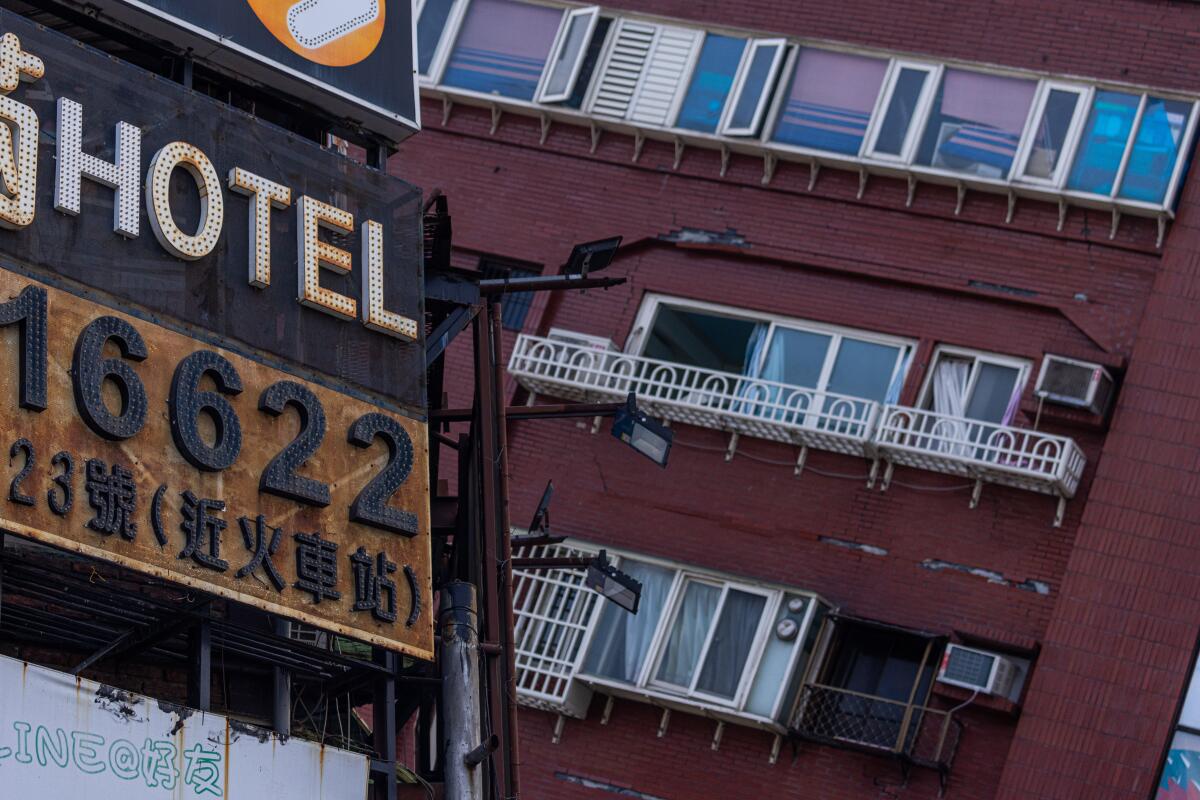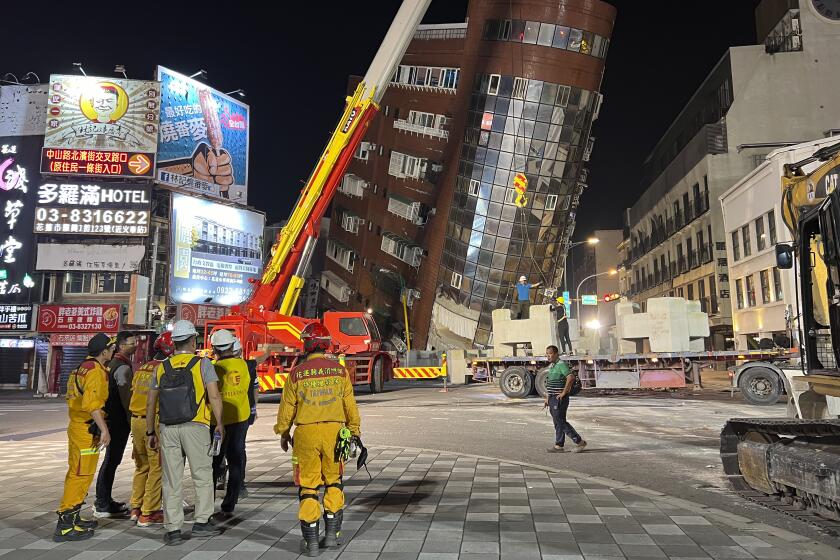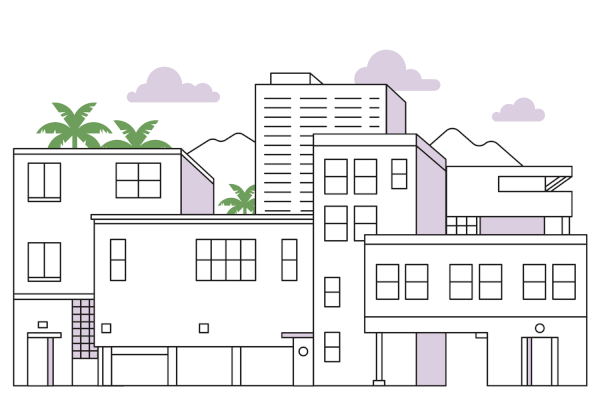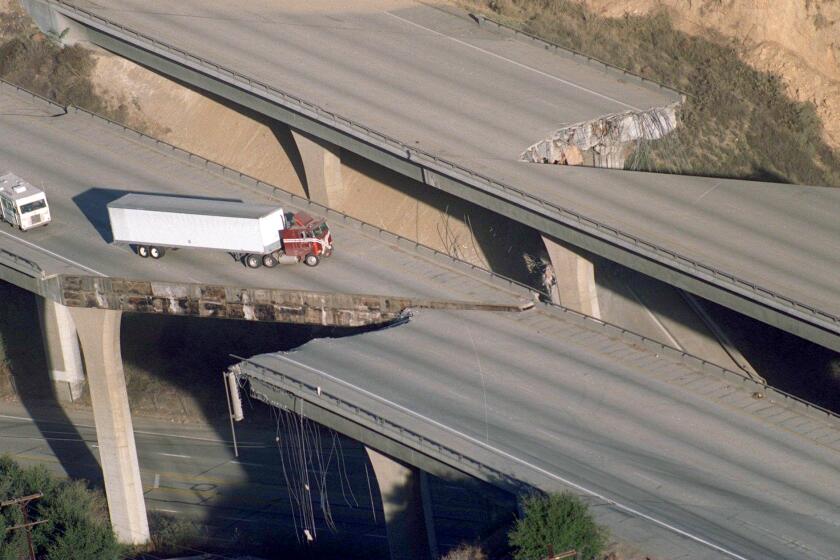Taiwan’s massive earthquake could happen in California. What we can learn from it

- Share via
A powerful rush-hour earthquake that rocked Taiwan, one of the best-prepared locations in the world for temblors, on Wednesday morning could provide crucial lessons for Southern California.
The quake, measured at magnitude 7.4 by the U.S. Geological Survey, killed at least nine people and injured hundreds on the island, which is about 1½ times the size of Vermont.
Like California, Taiwan is no stranger to powerful and damaging earthquakes. The factors that probably reduced the damage inflicted by Wednesday’s quake, the strongest on the island in 25 years, were the location of the fault, strong building codes and a collective effort to prepare for natural disasters, experts say.
“You put this earthquake in Taipei and you’d have a lot more damage. You put this earthquake in L.A. and we’d have way, way more damage,” said Lucy Jones, a seismologist and founder of the Dr. Lucy Jones Center for Science and Society. “Just recognizing that the fault didn’t get near a major population center is probably the most important factor.”
Hualien County, a sleepy tourist spot in eastern Taiwan about 100 miles from Taipei, the island’s capital, was close to the epicenter and saw the most damage. The first floor of several buildings across the city failed, leaving the multistory towers tilted on their sides. Authorities worked to free more than 100 people trapped in the wreckage.
Taiwan is regularly jolted by quakes and its population is among the best prepared, but authorities said they expected a mild earthquake and did not send alerts.
The buildings on the eastern part of the island — which house most of the Indigenous Formosans, who make up about 2% of the island’s population — are older than those in more urban areas. The buildings that collapsed are likely to be ones that hadn’t been retrofitted, experts say.
Taiwan’s last major earthquake was in 1999, when a magnitude 7.6 temblor struck about 90 miles southwest of Taipei, killing nearly 2,500 people. Officials reevaluated and strengthened building standards in the aftermath.
In Los Angeles, structural engineers have long warned about the risk of concrete buildings collapsing during a major quake, as happened during the 1971 Sylmar and 1994 Northridge quakes.
Still, many older buildings across California have yet to be updated to the latest standards, leaving them vulnerable to damage or collapse during a major earthquake. Depending on the type of building, retrofit fixes include adding such supporting elements as steel frames or beams, installing new concrete walls or repairing vulnerable welds.
“One thing that’s important to pay attention to is that there are still buildings that have not been retrofit,” said Patti Harburg-Petrich, a structural engineer. “One thing we can take away as a community from this earthquake is the importance of investing in those safety measures so we can make sure that when the Big One hits California, we can keep everybody safe.”
The Inland Empire is home to dozens of older brick buildings that haven’t been retrofitted. In Los Angeles, about 6,000 buildings have been identified as potentially in need of a retrofit, according to records obtained by The Times this year.
Los Angeles, Torrance, Pasadena, Santa Monica, Culver City, West Hollywood and Beverly Hills have all recently passed laws requiring certain vulnerable buildings to undergo retrofitting.
“The earthquake is inevitable, but the disaster is not,” Jones said. “We absolutely know how to build communities that will not come apart. We’ve just chosen not to do it.”
We mapped the Los Angeles-area condos, apartment and office buildings that still need a seismic retrofit. Large buildings built before 1996 may be in need of a retrofit.
Another striking similarity between Los Angeles and the portion of Taiwan that felt strong shaking during the earthquake is the soil condition. The Los Angeles Basin, just like Taipei, is basically “a big bowl of loose sediment” that can amplify movement, Jones said.
When the ground began to rumble in Taipei on Wednesday morning, an anchor at the SET News channel was standing in front of a camera in the middle of a broadcast. She attempted to maintain her balance as the room swayed. Small pieces of material from the ceiling rained down.
“I cannot even keep my standing posture and maintain my balance, especially with the ceiling shaking and many items falling off. I want to remind all the TV audiences to take care of themselves and be safe amid the earthquake,” she said in Chinese.
Lev Nachman, who has lived in Taiwan on and off since 2012, has grown accustomed to the occasional temblor. Taiwan is particularly vulnerable to quakes because of its position in the world’s most seismically active zone, known as the Ring of Fire.
The 31-year-old was jolted awake in his bedroom in Taipei just before 8 a.m. to the sound of his phone buzzing with a notification from the island’s automated earthquake alert system. The text message arrived about 30 seconds before the shaking started.
“It felt like a Disney ride that I didn’t sign up for,” he said. “A typical earthquake is kind of like if you’re on a chair and someone shakes you back and forth. This felt like if two people were playing tug of war with you on a chair.”
Some residents voiced concerns about the alert system because not everyone was notified. As in California, earthquake early-warning alerts go out only to people in areas that could be affected by severe shaking.
But experts say the notification system was an example of the technology working well.
Limiting the scope of the early-warning alerts prevents people from overreacting in areas at lower risk of damage. Taiwan’s system sends out a post-quake report to everyone on the network, informing people where the quake happened and how strong it was, UCLA geologist Lingsen Meng said.
That follow-up report serves both “to educate the public and to bring a sense of ease,” Meng said. “That’s something maybe we could learn here.”
Our understanding and preparedness have come a long way since Northridge’s magnitude 6.7 earthquake in 1994. We’re still learning from that destructive temblor.
Taiwan also benefits from a dense network of earthquake sensors all around the island. While California has a robust network of seismometers in the heavily populated Bay Area and Southland regions, coverage in the Mojave Desert and the Sierra Nevada is lacking, he said.
“We might want to [find] a way to use community infrastructure to host cheaper sensors, so that we have better coverage for earthquake warnings in California,” he said. More sensors in those areas would mean less lag time between the rupture and its detection.
The quake also triggered landslides in Hualien, which is a phenomenon Southern California is likely to experience during a large earthquake along the Sierra Madre or San Andreas faults, Jones said.
Seismologists have long urged Californians to prepare for the “Big One,” defined as a quake of at least a magnitude 7.8 — 2½ times larger than the one that hit Taiwan — along the southern part of the San Andreas Fault, which runs nearly the length of the state.
The rupture from Taiwan’s earthquake took place about 22 miles below the surface, said Susan Hough, a seismologist with the U.S. Geological Survey in Pasadena.
At its deepest, the San Andreas extends only 10 miles into the ground, meaning energy has less time to dissipate before erupting on the surface. “If anything, one would expect stronger ground motions” with an earthquake here the same scale as the one in Taiwan, Hough said.
The most important lesson California can learn from earthquakes elsewhere is that they are bound to happen, Hough said.
The last earthquake above 7.0 in California was a 7.1 temblor in Ridgecrest in 2019. It killed one person and caused $5.3 billion in damage. The only thing that prevented a far greater toll was the geologic good luck that it happened in an area less densely populated than California’s major cities.
“People can start to think that, ‘Well, yeah, earthquakes happen, it shakes, but they’re not that bad,’ ” Hough said. “But we’re going to have big quakes close to people.”
More to Read
Sign up for Essential California
The most important California stories and recommendations in your inbox every morning.
You may occasionally receive promotional content from the Los Angeles Times.
















